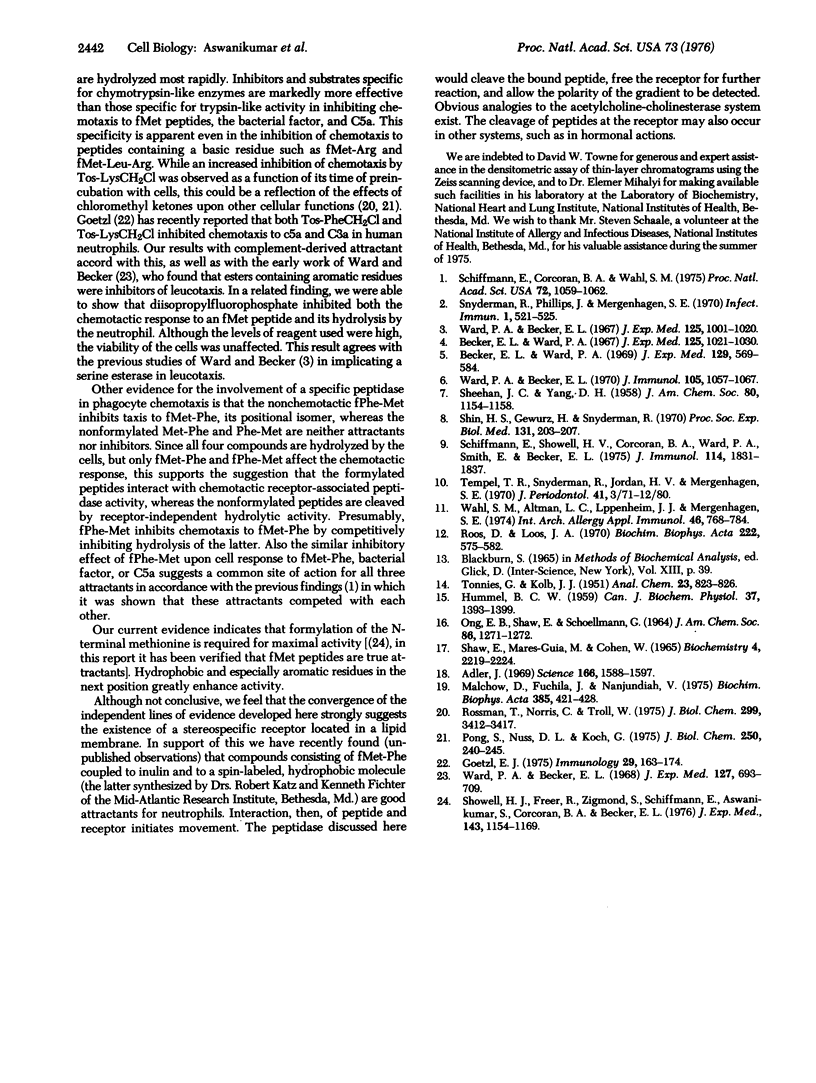Abstract
The potencies of N-formylmethionyl (fMet) peptides as chemotactic agents for phagocytes are related to the rates at which they are hydrolyzed. Furthermore, chloromethyl ketones inhibit chemotaxis as do the products of hydrolysis of fMet peptides. The directed migration of cells in response to such peptides is probably brought about by the binding of the peptide to a cell receptor with subsequent cleavage by peptidase specific for aromatic residues, a process that allows the chemical gradient to be detected.
Full text
PDF



Selected References
These references are in PubMed. This may not be the complete list of references from this article.
- Adler J. Chemoreceptors in bacteria. Science. 1969 Dec 26;166(3913):1588–1597. doi: 10.1126/science.166.3913.1588. [DOI] [PubMed] [Google Scholar]
- Becker E. L., Ward P. A. Esterases of the polymorphonuclear leukocyte capable of hydrolyzing acetyl DL-phenyl-alanine beta-naphthyl ester. Relationship to the activatable esterase of chemotaxis. J Exp Med. 1969 Mar 1;129(3):569–584. doi: 10.1084/jem.129.3.569. [DOI] [PMC free article] [PubMed] [Google Scholar]
- Becker E. L., Ward P. A. Partial biochemical characterization of the activated esterase required in the complement-dependent chemotaxis of rabbit polymorphonuclear leukocytes. J Exp Med. 1967 Jun 1;125(6):1021–1030. doi: 10.1084/jem.125.6.1021. [DOI] [PMC free article] [PubMed] [Google Scholar]
- Goetzl E. J. Modulation of human neutrophil polymorphonuclear leucocyte migration by human plasma alpha-globulin inhibitors and synthetic esterase inhibitors. Immunology. 1975 Jul;29(1):163–174. [PMC free article] [PubMed] [Google Scholar]
- HUMMEL B. C. A modified spectrophotometric determination of chymotrypsin, trypsin, and thrombin. Can J Biochem Physiol. 1959 Dec;37:1393–1399. [PubMed] [Google Scholar]
- Malchow D., Fuchila J., Nanjundiah V. A plausible role for a membrane-bound cyclic AMP phosphodiesterase in cellular slime mold chemotaxis. Biochim Biophys Acta. 1975 Apr 7;385(2):421–428. doi: 10.1016/0304-4165(75)90371-2. [DOI] [PubMed] [Google Scholar]
- Pong S. S., Nuss D. L., Koch G. Inhibition of initiation of protein synthesis in mammalian tissue culture cells by L-1-tosylamido-2-phenylethyl chloromethyl ketone. J Biol Chem. 1975 Jan 10;250(1):240–245. [PubMed] [Google Scholar]
- Roos D., Loos J. A. Changes in the carbohydrate metabolism of mitogenically stimulated human peripheral lymphocytes. I. Stimulation by phytohaemagglutinin. Biochim Biophys Acta. 1970 Dec 29;222(3):565–582. doi: 10.1016/0304-4165(70)90182-0. [DOI] [PubMed] [Google Scholar]
- Schiffmann E., Corcoran B. A., Wahl S. M. N-formylmethionyl peptides as chemoattractants for leucocytes. Proc Natl Acad Sci U S A. 1975 Mar;72(3):1059–1062. doi: 10.1073/pnas.72.3.1059. [DOI] [PMC free article] [PubMed] [Google Scholar]
- Schiffmann E., Showell H. V., Corcoran B. A., Ward P. A., Smith E., Becker E. L. The isolation and partial characterization of neutrophil chemotactic factors from Escherichia coli. J Immunol. 1975 Jun;114(6):1831–1837. [PubMed] [Google Scholar]
- Shin H. S., Gewurz H., Snyderman R. Reaction of a cobra venom factor with guinea pig complement and generation of an activity chemotactic for polymorphonuclear leukocytes. Proc Soc Exp Biol Med. 1969 May;131(1):203–207. doi: 10.3181/00379727-131-33840. [DOI] [PubMed] [Google Scholar]
- Showell H. J., Freer R. J., Zigmond S. H., Schiffmann E., Aswanikumar S., Corcoran B., Becker E. L. The structure-activity relations of synthetic peptides as chemotactic factors and inducers of lysosomal secretion for neutrophils. J Exp Med. 1976 May 1;143(5):1154–1169. doi: 10.1084/jem.143.5.1154. [DOI] [PMC free article] [PubMed] [Google Scholar]
- Snyderman R., Phillips J., Mergenhagen S. E. Polymorphonuclear leukocyte chemotactic activity in rabbit serum and Guinea pig serum treated with immune complexes: evidence for c5a as the major chemotactic factor. Infect Immun. 1970 Jun;1(6):521–525. doi: 10.1128/iai.1.6.521-525.1970. [DOI] [PMC free article] [PubMed] [Google Scholar]
- Tempel T. R., Snyderman R., Jordan H. V., Mergenhagen S. E. Factors from saliva and oral bacteria, chemotactic for polymorphonuclear leukocytes: their possible role in gingival inflammation. J Periodontol. 1970 Feb;41(2):71–80. doi: 10.1902/jop.1970.41.2.71. [DOI] [PubMed] [Google Scholar]
- Wahl S. M., Altman L. C., Oppenheim J. J., Mergenhagen S. E. In vitro studies of a chemotactic lymphokine in the guinea pig. Int Arch Allergy Appl Immunol. 1974;46(5):768–784. doi: 10.1159/000231176. [DOI] [PubMed] [Google Scholar]
- Ward P. A., Becker E. L. Biochemical demonstration of the activatable esterase of the rabbit netrophil involved in the chemotactic response. J Immunol. 1970 Nov;105(5):1057–1067. [PubMed] [Google Scholar]
- Ward P. A., Becker E. L. Mechanisms of the inhibition of chemotaxis by phosphonate esters. J Exp Med. 1967 Jun 1;125(6):1001–1020. doi: 10.1084/jem.125.6.1001. [DOI] [PMC free article] [PubMed] [Google Scholar]
- Ward P. A., Becker E. L. The deactivation of rabbit neutrophils by chemotactic factor and the nature of the activatable esterase. J Exp Med. 1968 Apr 1;127(4):693–709. doi: 10.1084/jem.127.4.693. [DOI] [PMC free article] [PubMed] [Google Scholar]


